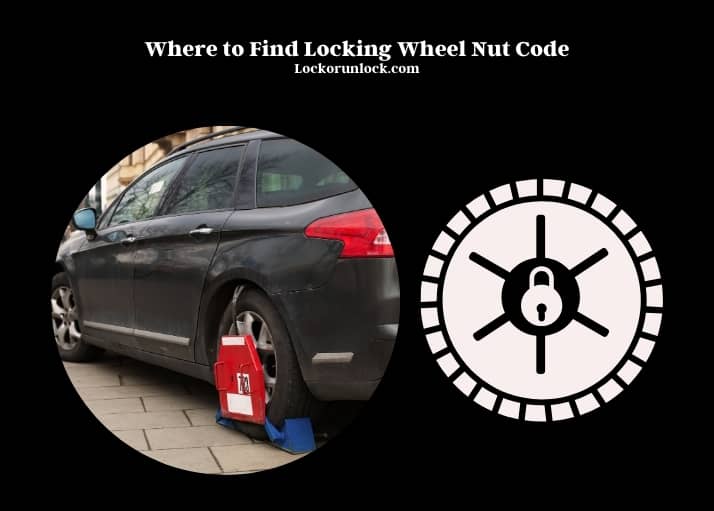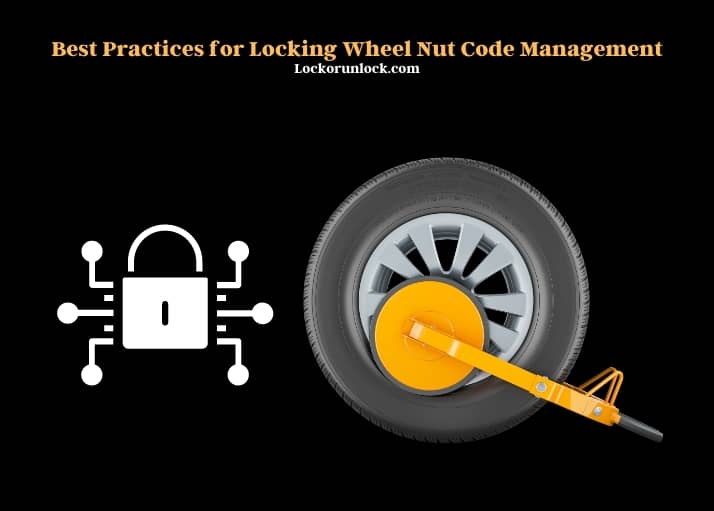The locking wheel nut code is typically found in the vehicle’s owner’s manual or on a card provided with the vehicle documentation. If not there, it may be stamped on the wheel nut key or lock.
Locking wheel nuts are a critical security feature in modern vehicles, designed to prevent the theft of wheels. These nuts can only be removed with a unique key or code, making them an effective deterrent against theft. In situations where the code is lost or unknown, several avenues can be explored.
Vehicle owners should first check their vehicle documentation, including the owner’s manual and any maintenance records, as these often contain the code or key. If the code is not documented, the next step is to contact the vehicle’s manufacturer or a local dealership. They can often provide the code based on the vehicle identification number (VIN).

For older vehicles or those purchased second-hand, finding the code can be more challenging. In such cases, reaching out to previous owners or consulting with a professional locksmith can be helpful. Locksmiths have specialized tools and expertise to either retrieve the code or replace the locking mechanism.
It’s important to keep the locking wheel nut code safe and accessible, as losing it can lead to complications during routine maintenance or in emergency situations. Regularly updating and securely storing the code ensures continued protection and convenience for vehicle owners.
Locking Wheel Nut Codes: Vital for Vehicle Security
Locking wheel nut codes play a pivotal role in vehicle security. These unique codes act as a deterrent against theft, as they require a specific key or code to remove the wheels. In the absence of this code, removing the wheels becomes a significantly challenging task for potential thieves.
This security measure is not only crucial for protecting the vehicle’s physical components but also impacts insurance claims. Many insurance companies consider the presence of locking wheel nut codes when assessing the risk and potential claim costs associated with vehicle theft or damage.
Furthermore, these codes are essential during vehicle maintenance. Mechanics often need access to these codes to perform tasks such as tire changes or brake inspections. Without the code, these routine maintenance tasks can become complicated, leading to increased labor costs and time delays. The significance of locking wheel nut codes extends beyond mere theft prevention; they are integral to the overall safety and upkeep of the vehicle.
Effective Strategies to Locate Your Locking Wheel Nut Code
Locating your locking wheel nut code can be straightforward if you know where to look. The first place to check is your vehicle’s documentation. Often, the code is listed in the owner’s manual or accompanying paperwork. If it’s not there, inspect the wheel nut key or lock itself, as some manufacturers print the code directly on these items.
If these methods prove unsuccessful, contacting the vehicle manufacturer or a dealership can be a fruitful next step. They usually have records of such codes and can assist in retrieval. The digital age offers online resources specifically for this purpose. Websites and databases dedicated to vehicle maintenance and security may have the information you need.
Don’t overlook common areas in your vehicle. The glove box, trunk, or even the compartment where the spare tire is stored are potential hiding spots for the code or the key itself.
Recovering a Lost Locking Wheel Nut Code
Losing your locking wheel nut code can be a stressful experience, but there are several steps you can take to recover it. Initially, it’s advisable to check any safe places where you might have stored the code. If that fails, look through previous service records or invoices, as the code is often recorded during maintenance sessions.
Reaching out to previous owners or sellers of the vehicle can also yield results, as they might still have the code or know where it is. If these avenues don’t work, professional locksmith services or wheel specialists can assist. They have tools and expertise to either retrieve the code or replace the locking mechanism altogether.
Using specialized tools or software to decode the locking wheel nut is another option, though it requires technical knowledge and specific equipment.
Navigating Challenges in Accessing Locking Wheel Nut Codes
Accessing a locking wheel nut code can sometimes present challenges, especially if the lock is damaged or the code is lost. In cases of damaged locks, professional services can remove or replace the locking mechanism. The cost of these services varies, but it’s a necessary expense for maintaining vehicle security.
If the code is lost, obtaining a replacement from the manufacturer or dealership is a viable option. This process might involve some paperwork and potentially a fee, but it ensures continued protection for your vehicle.
For those looking to avoid these hurdles, alternative wheel nut removal services offer a solution. These services can bypass the need for the code, providing a quick fix to an otherwise frustrating problem.
Best Practices for Locking Wheel Nut Code Management
Effective management of your locking wheel nut code is essential for maintaining vehicle security. Regular checks to ensure the code is accessible and in good condition are crucial. Storing the code securely is equally important; consider keeping it in a place separate from the vehicle to prevent it from falling into the wrong hands.

Updating the code, especially after changes to the vehicle’s wheels or tires, is another best practice. Keeping a backup copy of the code in a separate location is a wise precaution. Registering the code with relevant authorities or databases can provide an extra layer of security and ease in recovery if it’s ever lost.
Manufacturer Documentation Locations
| Manufacturer | Documentation Location | Manual Section |
| Ford | Glove Box | Maintenance |
| Toyota | Owner’s Manual | Security |
| BMW | Service Manual | Wheel and Tire |
| Honda | Trunk | Safety |
Online Resources for Locking Wheel Nut Codes
| Website Name | URL | Fee/Subscription |
| NutCodeFinder | www.nutcodefinder.com | Free |
| WheelSecure | www.wheelsecure.net | Subscription |
FAQs
Can Dealerships Provide Locking Wheel Nut Codes?
Dealerships are often a reliable source for retrieving locking wheel nut codes. If you’ve misplaced your code, contacting the dealership where you purchased your vehicle can be a helpful first step. They typically keep a record of such codes, especially for newer models.
For older vehicles or those bought from a private seller, the dealership might not have this information. In such cases, they can guide you on alternative methods to retrieve or reset your code. Remember, proof of ownership and identification may be required to access this sensitive information.
Is It Safe to Use Universal Locking Wheel Nut Keys?
Using universal locking wheel nut keys can be a tempting solution, but it’s not always the safest option. These keys are designed to fit a range of locking nuts, which means they might not provide the perfect fit for your specific wheel nuts.
This mismatch can lead to damage to the locking nut or the wheel itself. For the best results and to maintain the integrity of your vehicle’s security system, it’s advisable to use the specific key or code designed for your vehicle’s locking nuts.
Role of VIN in Finding Locking Wheel Nut Code
The Vehicle Identification Number (VIN) can sometimes assist in finding your locking wheel nut code. The VIN is unique to each vehicle and is used by manufacturers to keep detailed records. By providing your VIN to the manufacturer or an authorized dealer, they can often trace back to the specific features of your vehicle, including the locking wheel nut code. This method is particularly useful if the original documentation or key has been lost and the vehicle has not undergone significant modifications.
Impact of Aftermarket Wheels on Locking Wheel Nut Codes
Installing aftermarket wheels on your vehicle can affect the locking wheel nut code. Aftermarket wheels often come with their own set of locking nuts and a unique code or key. It’s crucial to keep this new code safe, as the original code for your vehicle’s factory wheels will no longer apply. If you switch back to the original wheels, remember to revert to the initial locking wheel nut code. Always inform your mechanic about any changes to avoid confusion during maintenance.
Are Locking Wheel Nut Codes the Same for All Models of a Brand?
Locking wheel nut codes are not universally the same across all models of a particular brand. Each vehicle model, and often each individual vehicle, has a unique locking wheel nut code. This specificity is a security measure to ensure that each vehicle has its own unique protection against wheel theft. Relying on a generic code for a brand would significantly diminish the security effectiveness of the locking wheel nuts.
Legal Implications of Tampering with Locking Wheel Nuts
Tampering with locking wheel nuts without proper authorization can have legal implications. These security features are in place to prevent theft and unauthorized removal of vehicle parts. Attempting to bypass or remove locking wheel nuts without the correct code or key, especially on a vehicle that is not legally yours, can be considered as an attempt at theft or vandalism. It’s always best to seek professional help or contact the vehicle’s owner for the appropriate code or key.
Summary
The importance of locking wheel nut codes in vehicle security cannot be overstated. From preventing theft to ensuring smooth maintenance procedures, these codes are integral to the safety and functionality of modern vehicles. Knowing how to locate, recover, and manage these codes is essential for any vehicle owner. The strategies and best practices outlined in this article provide a comprehensive guide to dealing with locking wheel nut codes, ensuring your vehicle remains secure and well-maintained.
